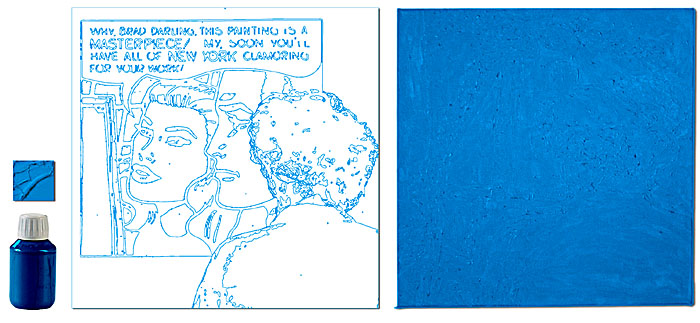
I_SELF, MASTERPIECES - FACING ROY LICHTENSTEIN, monochrome painting with acrylic paint and light
“MASTERPIECE”, Roy Lichtenstein, 1962, 54 x 54 inch, Collection of Agnes Gund, New York
Each set contains:
1 pre-printed stretched canvas (40x40cm) or alternatively 1 slide (variable sizes, re-usable)
1 color of artist acrylic paint (optionally cyan, magenta, yellow or black)
3 artist brushes in different sizes, adhesive label with the signature of the artist, instruction sheet
©Christin Lahr 2005/06, www.I-SELF.de, Painting by Numbers, Monochrome Painting Kit, Sale Item Nr.: #253/cyan
Using the REAL ART KIT and instruction manual, the curators must assemble and finish the work of art. Responsibility will be conceded by the artist. On the one hand, the operation manual is very specific, but on the other hand it leaves options open. The instruction sheets are the main components of the work of art. They define how the work should look and also serve to manifest the differences between concept and realization. There will always be a description, if nothing (else). The entire exhibition space could be seen as one big unit which has to be put into operation like an unknown machine. Before operating the unit, the manual should be read thoroughly and retained for future reference. Interaction with the curators as well as the visitors is provoked in many ways. The work of art is explicitly an invitation, and, in fact, a demand to perform. Visitors become actors and part of the work of art. They could also take on the role of the artist. The artist formerly known as the originator becomes an observer now, but might soon return as a viewer, actor, artist …
The artist will not actually be present. Could a work of art get out of control? The outcome remains to be seen …